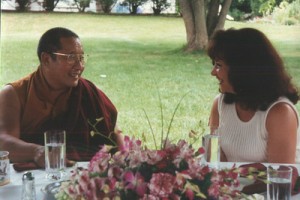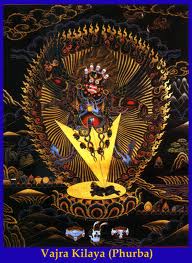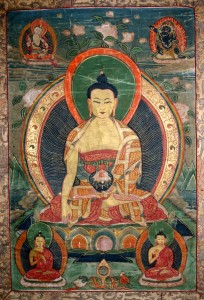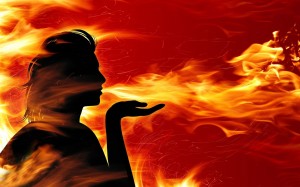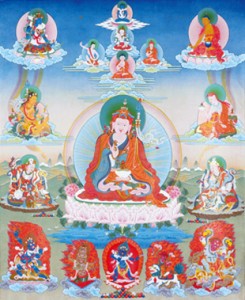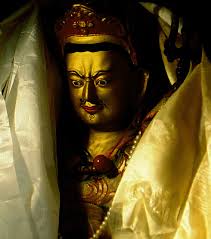The following is an excerpt from a teaching by Jetsunma Ahkon Lhamo:
I would like to show you one more technique that you can use. This is a very common technique. It’s a sending and receiving, but with a slight variation.
The first time that I met His Holiness Penor Rinpoche, this was the first thing he told me to do. His Holiness asked me, “Do you wish there to be no more suffering?”
“Of course! Of course, this is my only wish.”
Then he said, “As a Bodhisattva, will you take on the suffering of others, if you have the opportunity?”
I said, “Of course!”
And then he said, “Do you think if you do, that it will harm you?”
I said, “No, of course not. How can love harm somebody? That’s ridiculous!”
And he said, “Well, I’ll tell you, when you have faith in the Three Precious Jewels, the Buddha, the Dharma and the Sangha, and you align yourself with the great purpose of the Bodhisattvas, then you have nothing to fear.” And he said, “In that case, let me teach you how to practice.” He said, “Every breath that you take, every moment that you walk around, your breath is a cycle of OM, AH, HUNG.”
OM. We take in the suffering, no matter what it is, of all sentient beings, no matter who they are. We breathe it in. OM.
AH —is the space between the inhale and the exhale. AH is an immediate meditation on non-duality with the Three Precious Jewels, an immediate meditation on the nature as it is—inseparable, indivisible, free of concept. So there’s that meditation. AH.
And then, HUNG. Breathe out all of the virtue and merit that you and all practitioners have accomplished in the past, in the present and in the future. (This is like a spiritual credit card deal. You get to borrow on what you hope you’re going to do later).
So it’s OM, I take in the suffering of all sentient beings. I’m not separate. AH, I rely on the Three Precious Jewels. I am inseparable from the Three Precious Jewels. I rely on the strength of the Three Precious Jewels. And I am that. HUNG, I offer all of my virtue and merit, all the good I have ever accomplished in the past, present, and future, for the liberation and salvation of all sentient beings, every breath.
To walk past poor people, different colored people, people of different religions, and breathe in their suffering, breathe it in, really breathe it in. Hold your place, hold the line. Hold your place as a representative of the Buddhas and Bodhisattvas on this earth with confidence, vajra courage. Then breathe out to them all of the virtue and merit that you have accomplished in the three times. Every breath of your life. It’s very, very hard to do at first because you get a little obsessive. OM-AH-HUNG, OM-AH-HUNG. People that have practiced watching the breath realize that once you start watching the breath, the breath starts acting weird. But little by little, you practice and you get through that. It becomes a very natural, sincere and very deep intention. Freely, I take on. Spontaneously, I abide naturally. Freely, I offer what I have. In a way, you become like a circle, inseparable from all that is, inseparable from others. You have the sense, eventually, of breathing for them, of inhaling and exhaling for them, of carrying them, of being completely inseparable from them. In that meditation, you find yourself just singing, ‘I love you.’. Is it okay for a Buddhist to say something, oh I don’t know, gushy? Yes it is. Because although the Buddha used different words, like compassion, in the west we are more familiar with the word ‘love.’ And so, to hold ‘all that is’ within you and from that place of mystical awareness, instead of painting a picture, ‘I love you,’or an affirmation, ‘I love you,’ to know from the depth of your being, ’I love you,’ it will change your life. And it will change our community if we begin to practice in that way.
Here we are asking for recognition. Not just saying the words. Not just doing the practice. But recognition. This is a different step. If we are going to be potent in our spiritual lives, and if Buddhism is going to be a potent force in this world, that’s where it has to start. And the great thing about spiritual practice is that there is no time better to start it than right this minute. I’d like to invite you to participate in that.
Now you know my everlasting practice. This is what I do all the time, because my teacher told me to, and I wish to repay his kindness. So I’m doing that all the time. I also find that when I meditate in a mystical way, and experience, accept and awaken to the inseparability and non-duality of all that lives—the sameness, the equality of all that lives—I’m always inspired, because there’s nothing else but to offer all that I have—my feet, my legs, my torso, my arms, my neck, my head, everything—for the liberation and salvation of all sentient beings. This is how to be moved by your practice, to be deep in your practice. This is why you’re wearing the robes, because you are ministers. It’s hard for us to understand because of the cultural change, but you are ministers. Make circumambulation around the Stupa. Pray to Guru Rinpoche as sincerely as you can that this pact that you have made is sealed. Pray that you will accomplish this. Pray that you will be a spiritual voice in a world that is longing to hear such a voice.
Copyright © Jetsunma Ahkon Norbu Lhamo All rights reserved
